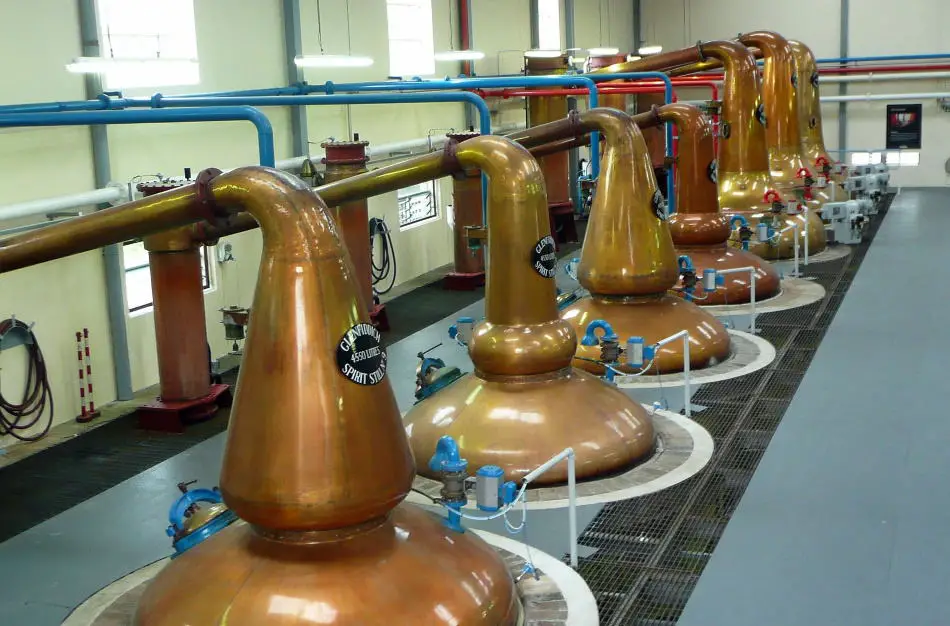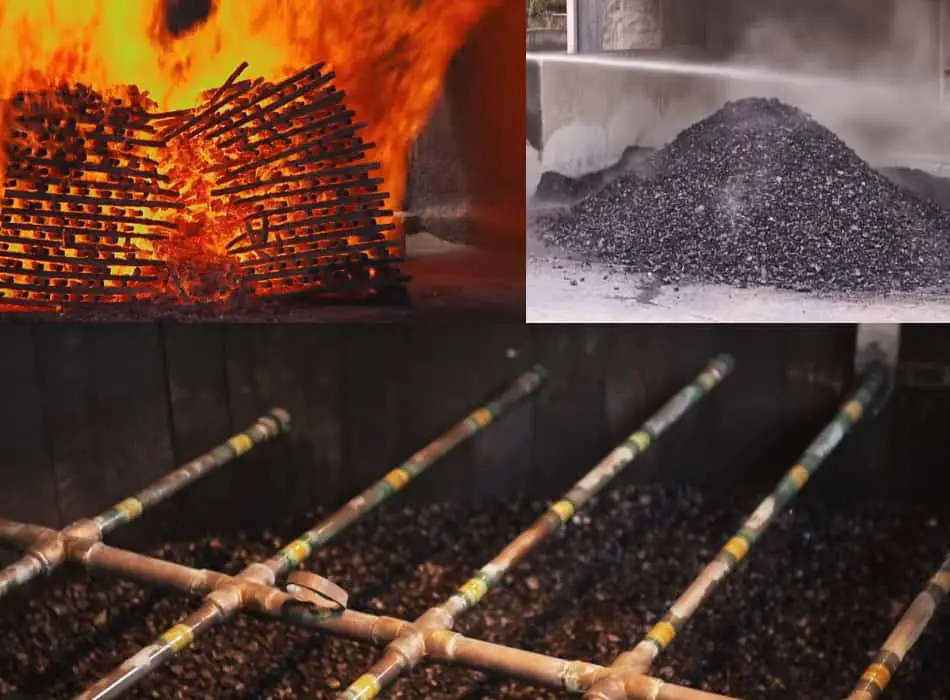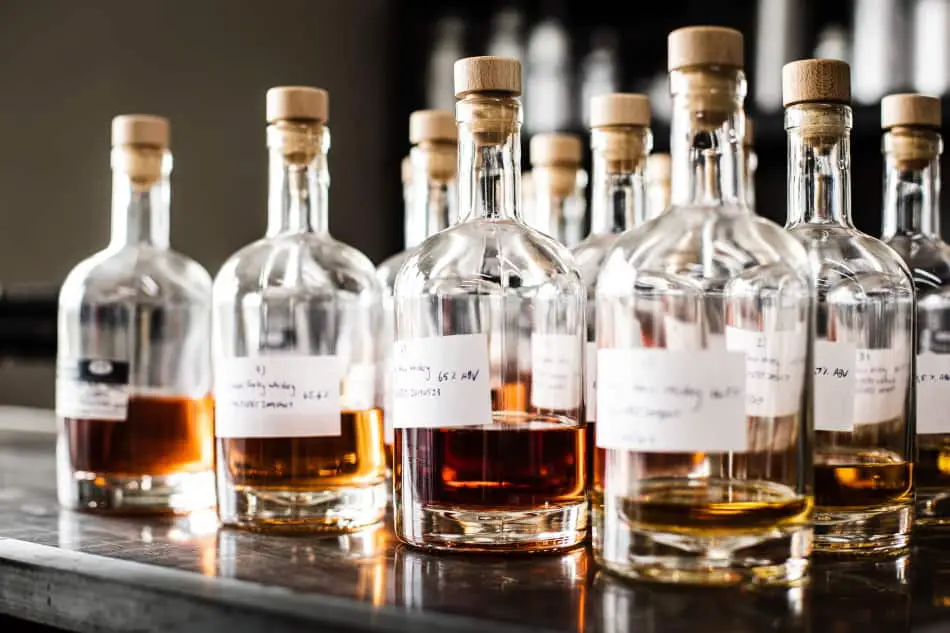The issue of smoothness is important when it comes to whiskey. No one wants to drink a whiskey that ‘burns’ or is ‘harsh’ which is why distilleries put in a lot of effort to make their whiskeys as smooth as possible. As I have learnt more and more about whiskey it seems to me that there are at least 10 things that help make a whiskey smooth.

1. Being Made from High Quality Ingredients
Being made from high quality ingredients helps to make a whiskey smooth because they’re less likely to contain anything unpleasant or bitter – which is the exact opposite of smooth. Many distilleries create their own strain(s) of yeast, so this really only applies to the other two ingredients used to make whiskey – grain and water and for them to be high quality means:
- Grains that are clean and without any foreign materials or cracks so that nothing unpleasant can enter the kernel and contaminate it.
- Spring water that’s clean and pure and has passed through many layers of limestone which filters out any iron in it. Iron reacts with alcohol turning it black and bitter.
2. Being Made from Grain with Sweet or Soft Flavors
A whiskey with sweet or soft flavors is smoother. The grain or grains a whiskey is made from will affect its final flavor and although any can be used most distilleries choose grains on the basis of the flavors they will impart to the whiskey.
The following table shows the most common grains used to make whiskey and the type of flavors they gives it:
| Grain | Flavor |
|---|---|
| Corn | Sweet |
| Wheat | Soft |
| Rye | Spicy |
| Malted Barley | Sweet |
As you can see, with the exception of rye that imparts a spicier and perhaps harsher flavor to the whiskey – which by the way is quite popular, most of the grains that are commonly used to make whiskey impart sweet or soft flavors making it smoother.
Of course, the ratio of the different grains in the mash bill will affect the level of sweetness in the whiskey and therefore how smooth it is. For example:
- Bourbons are made from at least 51% corn. As corn is the most sugary grain used in whiskey production, bourbons are generally the sweetest of all whiskeys.
- Many American whiskeys are made with 70% – 90% corn. Well, if you’re using the most sugary grain used in whiskey production you might as well use a lot of it.
- Single malt Scotches are made with 100% malted barley. Malted barley is also sweet (but it’s a caramel and toffee sweet as opposed to the vanilla and white sugar sweet of corn).
- American wheat whiskeys are made from at least 51% wheat which gives it a soft and gentle flavor.
3. Being Distilled in Copper Stills

Even if whiskey is made with high quality ingredients so that any contaminants are kept out, the grains may still contain some unpleasant flavors compounds. Also, during the process of fermentation not only does the yeast turn the sugars from the grains into alcohol, it also creates by-products, some of which have unpleasant and harsh flavors.
This can be made worse during the distillation process where the alcohol is concentrated as this concentrates the unpleasant by-products too!
Fortunately, many aspects of the distillation process are designed to remove as many of these unwanted aroma and flavor compounds as possible so that the final product is smoother than it otherwise would be.
One of these aspects is using stills made of copper for the distillation process. This is because copper binds with sulfur – one of the unpleasant by-products created by the yeast during the fermenting process, keeping it in the still and out of your whiskey.
4. Being Distilled More Times
The purpose of distillation is to separate the alcohol from the water so it can be concentrated. Helpfully this also separates out many unpleasant tasting impurities that would give whiskey a harsh taste. So obviously, the more times a spirit is distilled the more unwanted flavor compounds are removed and the smoother the whiskey will be.
That’s why Scottish distilleries generally distill their whiskies twice and Irish distilleries generally distill their whiskeys three times!
Even within one distillation the spirit can be redistilled. If the alcohol vapor hits the sides of the still, then instead of moving into the condenser to be cooled and collected it will fall back down into the liquid it came from, only to be vaporized again and leave even more impurities behind. The larger the still the more this condensing-vaporizing cycle will happen within one distillation, and the more impurities will be separated out from the alcohol.
Similarly, the higher the ABV a spirit is distilled to, the less unpleasant flavor molecules there will be. This is obvious as the more alcohol there is in a liquid the less room there is for anything else. By law bourbons can’t be distilled to more than 80%ABV but Scotch whiskies can be distilled to 97.4%ABV. But that doesn’t mean bourbons have more unpleasant aroma and flavor compounds as there are more ways to filter them out so that you end up with a smooth whiskey.
5. A Narrower Distillation Cut
There are three parts to the distillate. The first is the foreshoots or the heads which are high in alcohol and may be dangerous to drink. The last is the feints or the tails which are weak. Both are pungent and not great taste wise.
Alcohol from the middle or the heart of the distillation is tastier.
This is more important in pot stills where alcohol is distilled in batches and not continuously and each batch has to be cut to keep the best part of the distillate. Precisely how it’s cut varies from distillery to distillery, but it affects the flavor and smoothness of the whiskey.
- Wider cuts include more of the heads and the tails. It’s done to reduce the cost of production, but it leaves in more of the unpleasant and harsher flavors.
- Narrower cuts exclude more of the heads and the tails, removing more of the harsher flavors from distillate so you finish off with a smoother whiskey.
6. Charcoal Filtration
All Tennessee whiskeys are filtered through charcoal before being matured to eliminate impurities and make the whiskey smoother.
Jack Daniel’s is a Tennessee whiskey known for being smooth, mostly because of this process to which they pay special attention, as they grind the charcoal down into small pieces to increase the surface area for the off-flavor molecules that are being filtered out to stick to, and they filter their whiskeys through 10-feet of sugar maple charcoal over three to five days.

One of their whiskeys (Jack Daniel’s Gentleman Jack) is charcoal filtered twice, once before going into the barrels and once after maturation. This removes any remaining impurities, making it even smoother than the smoothness of the other Jack Daniel’s whiskeys.
7. Maturation in a Charred Barrel
Many distilleries use charred barrels for the maturation process as it makes the whiskey smoother.
Charring a barrel simply means setting it on fire for, depending on the char level, between 15 to 55 seconds. This does two things. First it caramelizes sugars in the wood of the barrel, which the whiskey picks up during the years it spends maturing, giving it more sweet flavors and smoothness.
Second, charring a barrel creates a charcoal layer in the wood that filters out unwanted flavors. This is similar to the charcoal filtering done when making Tennessee whiskeys only with a layer almost 10-feet smaller than the one Jack Daniel’s uses.
In the United States, whiskeys must be aged in charred oak barrels. Scotch whiskey is usually aged in ex-bourbon barrels that were obviously charred.
8. Longer or More Intense Maturation Time
The longer a whiskey spends maturing in the barrel the smoother it will be. That’s because during maturation the whiskey picks up flavors from the wood of the barrel and the unpleasant compounds evaporate through the barrel walls. The longer the maturation the more sweet flavors will be added to the whiskey and the more unpleasant compounds will evaporate.
However, since it’s aspects of the environment that cause the whiskey to seep in and out of the barrel walls to pick up flavors and cause the unpleasant compounds to evaporate, if they’re more intense the aging process will be accelerated causing the whiskey to be as mature and smooth as one aged for longer in a less intense environment.
That’s why bourbon which is aged in Kentucky with its warmer temperatures and seasonal fluctuations is aged for less time than Scotch whiskies that are aged in the year-round mild temperate climate of Scotland but can be just as smooth.
Since all whiskeys are made differently there are no fixed rules that state whiskeys aged for this amount of time are that amount of smooth (assuming it’s correct to say ‘that amount of smooth’ in the first place), but a general rule is:
- Bourbon aged for five years will be much smoother than bourbon aged for two years
- Scotch aged for 10 years will be much smoother than Scotch aged for three years
9. Being Well Balanced

Another thing that makes whiskey smooth is being well balanced. Well balanced is just the whiskey drinkers fancy way of saying that a whiskey’s flavors are nicely integrated and work well together. This is important because it’s not always the case. Whiskeys can contain many flavors and sometimes one is dominant, or the flavors work against each other creating a jarring drink that lacks a certain smoothness.
This is especially important in blended whiskeys which can be a mixture of between 15 and 60 individual whiskeys each of which in turn, can have several dozens of flavors. The master blender will have done his best to ensure the flavors work well together in a flavorful but well balanced and therefore smooth whiskey.
10. Reducing the Impact of the Alcohol
Whiskey has an alcohol content of anywhere between 40%ABV to 68%ABV. Even at the lowest end that’s still a lot of alcohol so it’s no wonder that despite all the other things that are done to make whiskey smooth, many people still find that it ‘burns’ or is ‘harsh’.
That’s why whiskey drinkers do several things to reduce the impact of the alcohol and make their whiskey smoother. These things are:
- Drink whiskey from a nosing glass as it lets air get to the whiskey so it can breathe, which causes some of the alcohol to evaporate.
- Add water to dilute the whiskey.
- Add ice to lower the temperature of the whiskey and when it melts, dilute the whiskey too.
- Acclimatize their nose and palate to the alcohol by smelling the whiskey gently until their nose becomes desensitized to it and by taking a pre-tasting sip so their mouth becomes acclimatized to the alcohol too.
For more information about reducing the impact of the alcohol in whiskey, see this more detailed article I wrote about it here.
Ten Smooth Whiskeys
Having gone through all the things that make whiskey smooth, I thought it only fair that I point you in the right direction by mentioning some of them and (where necessary) their less obvious reason for being smooth.
- Jameson Irish Whiskey – triple distilled
- Laphroaig 10 Year Old
- Woodford Reserve – aged about 7 years
- Crown Royal – blend of 50 full-bodied Canadian whiskies
- Auchentoshan 21 Year Old – triple distilled
- Glenmorangie 18 Year Old
- The Glenlivet 12 Year Old Double Oak – matured in two casks
- The Macallan Sherry Oak 12 – matured in Oloroso sherry seasoned casks
- Jack Daniel’s Old No. 7 – charcoal filtered
- Chivas Regal 12
You can buy any of these whiskeys at drizly.com here .
.
